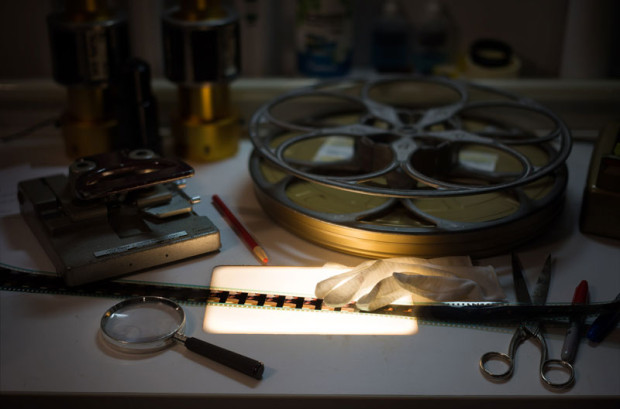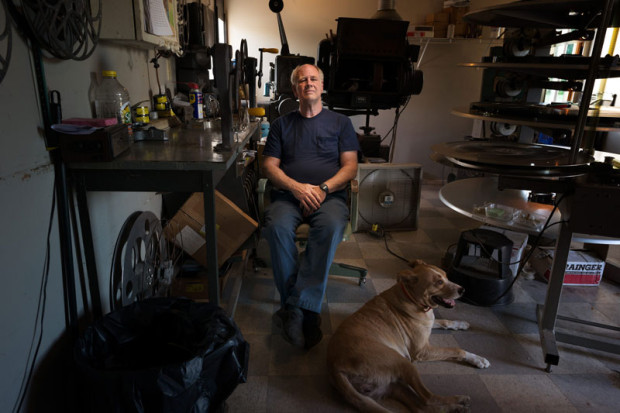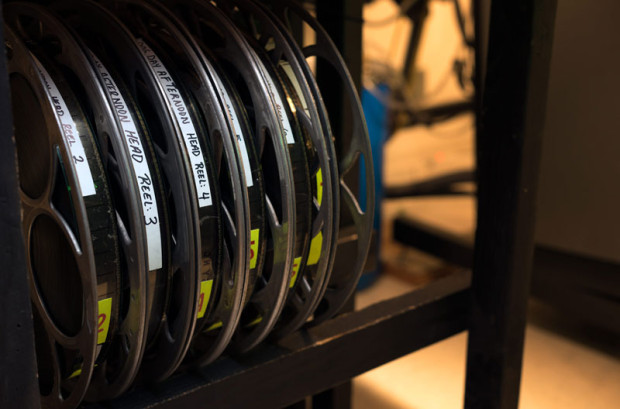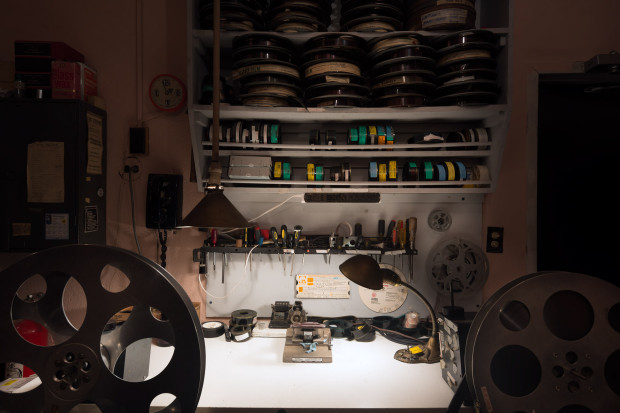An iconographic and text archive related to communication, technology and art.
☛ Joseph O. Holmes Photography: Roxy Theater, Northampton, PA, from The Booth series, 2012. © Joseph O. Holmes. Used with permission.
Joseph O. Holmes is an award-winning photographer based in Brooklyn, New York (not to be confused with Joseph Holmes from Kensington, California). In 2012, he made a series about the disappearing art of film projection. For this series, he documented the workspace of projectionists working in and around New York city. Many of the theaters he visited were on the verge either of being converted to digital cinema, or of closing. At the time, I included one of his image in a blog post I wrote about the transition away from 35mm.
Since October 5, 2013, and up until February 2, 2014 Jospeh O. Holmes series is being exhibited at the Museum of the Moving Image, in Astoria (NY): The Booth: The Last Days of Film Projection. Here’s what actor/director Steve Buscemi had to say about it:
For most of us who love going to the movies, the projection booth and what goes on in there is a bit of a mystery, if we even think about it at all. I, for one, am glad that Joe Holmes not only thinks about it, but has taken the time to document it in his unique way… Each image offers a glimpse into a private world that is all but gone…

As an accompanying piece, Joseph O. Holmes also created a 12-minute video tribute to film projection. It is entirely made of movie excerpts from 46 different titles, together covering a period of 85 years of filmmaking. They all have in common one thing: all the sequences are about projections booths. The editing was made with a lot of attention to details, a nice sense of rhythm, and a lot of humor. The result is a real treat to watch:
Projection booths in the movies are filled with murders and romance, monsters and dames, surreal encounters and tender moments, all climaxing during the crucial and –until the platter system arrived– inevitable changeover. From The Blob (1958) to The Inglorious Basterds (2009), all the way through Masculin Féminin (1966), Im Lauf der Zeit (1976), Gremlins (1984) and Cinema Paradiso (1988), many of these movies are well worth (re)watching again and again.
After enjoying this procession of fictional booths, I contacted Mr. Holmes. I wanted to learn more about the real booths he had visited during the making of his photographic series. He generously accepted to answer a couple of questions by email.
Projection booths are not always easily accessible, nor prominently featured in a movie theater: they remain largely ignored spaces. I first asked Mr. Holmes what had attracted him into those dark rooms.
I love movies and I have since I was a youngster, but the reason I was eager to shoot this series about projection booths was because I love to discover and photograph private workspaces. I find a cluttered workspace fascinating, and one day I realized that projection booths are both very private and probably filled with fascinating clutter and tools and mementos. So I approached the manager of a theater I had met earlier when I photographed the theater’s ticket booth and asked if I could explore the booth. I got lucky: she set me loose in there, unsupervised, and I ended up spending many hours, over several weeks, exploring and discovering how I wanted to shoot such a dark and dingy room.

One can see more of Holmes’s photography about workplaces at the Jen Bekman Gallery website. The photographic work documenting projection booths is especially important at this critical moment, when theaters are either converting or closing. Exhibitors even have the option to adopt “boothless projection system” that completely “eliminate[s] the need for a traditional projection booth” (as the manufacturer Christie puts it in a promotional video).
Since he is a photographer and an avid moviegoer, I asked Mr. Holmes what was his own reaction to the transition: did he noticed the change and if so, what was his reaction?
I wasn’t yet aware that film projection was headed toward extinction. Once I began reading about transition to digital, I worried that the look of a movie on a screen would decline. For a time, for example, it was easy to spot a movie that had been shot using digital cameras. I remember how disappointed I was in the look of Michael Mann’s Collateral. Early digitally-shot movies were ugly (though things have definitely improved). But at least through my eyes, digital projection looks just fine. I never notice whether I’m watching a movie in digital or film.

Since the booth he visited were still occupied by qualified projectionists, I asked Mr. Holmes how were those men and women and how they felt about the ongoing transition.
Most of the projectionists I talked to were philosophical about the change — they were happy to come to work and do whatever it took to make the movies run, whether it was a digital or analog process.
But digital projection requires a lot less work from a projectionist. I was in a booth two years ago and watched through the window as the house lights were dimmed, the movie trailers were played, the lights were brought all the way down, and the main feature started ― all automatically by way of a laptop, with no human intervention. So the real problem is that huge numbers of projectionists are losing their jobs. Some of the projectionists I shot for The Booth have already lost their jobs.
And many theaters have closed or are in danger of closing. Converting to digital projection costs tens of thousands of dollars, and small theaters that run on a shoe-string budget can’t afford the change. And the day is quickly approaching when movies will no longer be delivered on film. Some studios are already distributing only digitally. So theaters are forced to change to digital projection or shut down. That’s a shame. My hometown theater, The Ritz in Muncy, PA, is in danger of closing after almost 90 years.

As one can imagine, the workspace in a projection booth is often only dimly illuminated. This must have represented a special challenge for a photographer and I asked Mr. Holmes how he managed his photo sessions.
I dealt with the light two ways: for photos of the booth and projectors, etc., I just enjoyed emphasizing the odd light. For photos of people, that is, for all the portraits, I brought my own lights. I held a soft box to light each projectionist. Otherwise, I would have had a whole series called “Silhouettes of Projectionists!”
Finally, since this was about the transition from film to digital, I couldn’t help but asked about the kind of camera used to make The Booth series.
People sometimes find it ironic that I’ve shot the entire Booth series on a digital camera, a Nikon D800 digital SLR. But I switched completely to digital back in 2004 or 2005 for the convenience, and I haven’t looked back.
To discover more about Joseph O. Holmes photography, one can browse through his portfolios on his official website or explore his Flickr account. See especially the “Texters” set, as well as the “NYC Xmas Tree Vendors” set. He’s also has a blog and maintains a presence both on Twitter and Tumblr.
There are many interesting interviews about him and his work available online. Here are only a few of them:
-
F-Stop: “Interview with photographer Joseph O. Holmes by Angela Niman”, October 8, 2013. Here’s an excerpt:
AN: You were in exhibition earlier this year at the Jen Bekman Gallery in New York. What do you hope people see, feel or perhaps learn when they look at your photographs? What feedback or reactions have you received from your exhibitions?
JOH: I love printing, and I believe that my photos are at their best as prints, so exhibitions are really important to me. The Internet has become the de facto exhibition space for billions of photographers, but looking at a print is a completely different experience, an essential experience. I don’t believe anyone has really seen some of my most popular images until they’ve seen prints.
-
LENSCRATCH: “Joseph O. Holmes: The Booth” September 30, 2013. More about The Booth series:
Ever since I first starting going to the movies, I’ve been intrigued by the tiny windowed room above the audience. I imagined a projectionist threading film into a complicated maze of wheels and sprockets, or splicing trailers under the dim light of an editing table, or maybe even staring back at me from the shadowy recesses.
-
From The Desk Of: “Joseph O. Holmes” January 9, 2012. That’s an interview about Holmes’s own workspace:
FYD: What is your favorite or most required work tool?
JOH: I’ve always been on a quest for a camera that’s totally transparent. And though no camera could even be truly transparent, my Nikon D700 is the closest I’ve come yet. I love using it. It’s at the point where I simply don’t think about it any more; it’s like an extension of my hand and my eye. If only it were a couple pounds lighter.
-
Rib Galbraith: “Feature: the quiet, lovely photographs of Joseph O. Holmes” by Eamon Hickey, April 27, 2011.
• • •

- By Philippe Theophanidis
- on
- ― Published in Art, Movies, Photography, Technology
- Tagged: 35 mm, celluloid, cinema, digital, film, obsolescence, projection, projectionist, theatre

